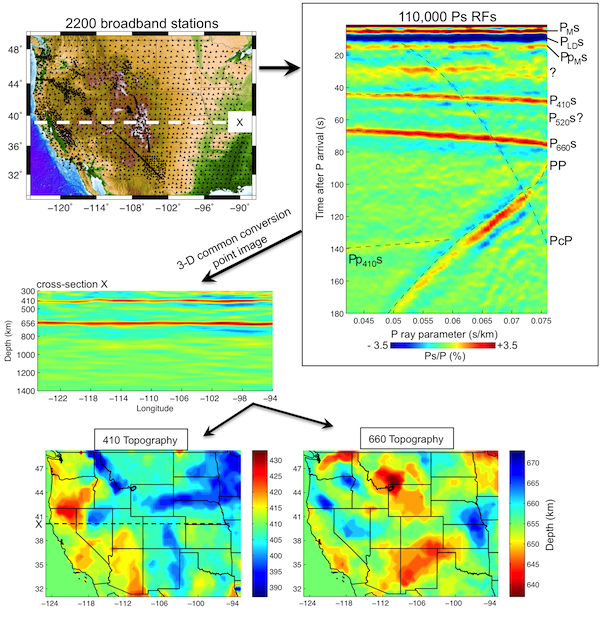2012 IRIS Workshop
Mapping Transition Zone Topography Beneath USArray
Brandon Schmandt: Caltech, Ken Dueker: U. Wyoming, Steve Hansen: U. Wyoming
Upper left) Map of the >2200 broadband stations used for Ps receiver function analysis. Upper right) A time versus ray-parameter image made by stacking RFs in ray parameter bins. Specific Ps and direct teleseismic phases are labeled, including Ps scattering from the Moho (M), lithospheric discontinuities (LD), 410, and 660. Middle left) An example of a slice through the CCP volume at 40° latitude. Bottom) Maps of topography on the 410 and 660 derived from the CCP image.

Full-resolution graphics file in original format: 0061.png
Earth’s mantle transition zone is spatially defined by high gradients in seismic velocity between about 400-800 km depth, and the dramatic changes in elastic properties are thought to reflect mineral phase transformations and possibly chemical layering. Availability of a dense wide-aperture broadband array as a result of EarthScope allows seismic velocity gradients in the transition zone to be imaged in great detail beneath a large portion of North America. The two most prominent velocity gradients in the transitions occur near 410 and 660 km depth, which agrees well with mineral physics predictions for phase transitions in a pyrolite mantle. Consequently, mapping variations in the depth and sharpness of these discontinuities provides a means to remotely detect spatial variations in the thermo-chemical properties of the mantle. For example, regions where the 410 is shallower than average or the 660 is deeper than average probably reflect cool mantle temperatures as a result of past subduction at the western plate margin. Regions where the 410 is deeper than average or the 660 is shallower than average probably reflect warm temperatures. These warm regions may be related to the occurrence of Cordilleran intra-plate volcanism in some cases, most notably the Yellowstone hotspot. However, factors aside from temperature such as variations in major elements like iron or volatiles like water are also thought to induce changes in mantle phase transformations. So a broad suite of seismic constraints including discontinuity structure and 3-D images of continuous P and S velocity structure are necessary to confidently infer mantle physical state and composition. Such integration of high quality seismic results spanning a large and tectonically diverse region has not previously been possible. Ongoing and future efforts in this direction will provide a systematic view of thermo-chemical convection beneath North America and its connections to tectonic processes.
Acknoweldgements: This research is supported in part by the Gordon and Betty Moore Foundation through the Tectonics Observatory at Caltech.
For further reading: Schmandt, B., K. G. Dueker, E. D. Humphreys, S. H. Hansen (2012), Hot mantle upwelling across the 660 beneath Yellowstone. Earth and Planetary Science Letters, 331-332, 224-236, doi:10.1016/j.epsl.2012.03.025. doi: 10.1016/j.epsl.2012.03.025
Keywords: transition_zone, receiver_functions
